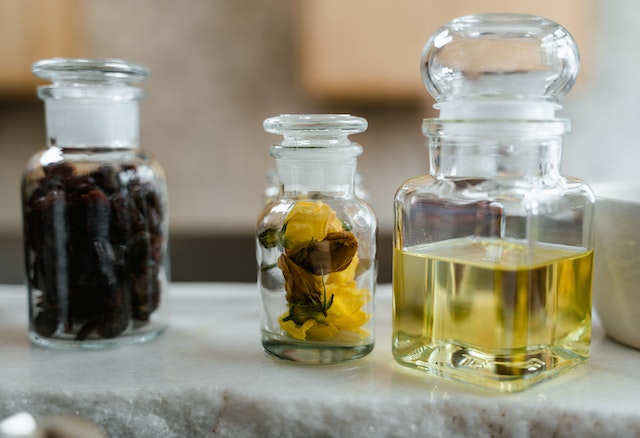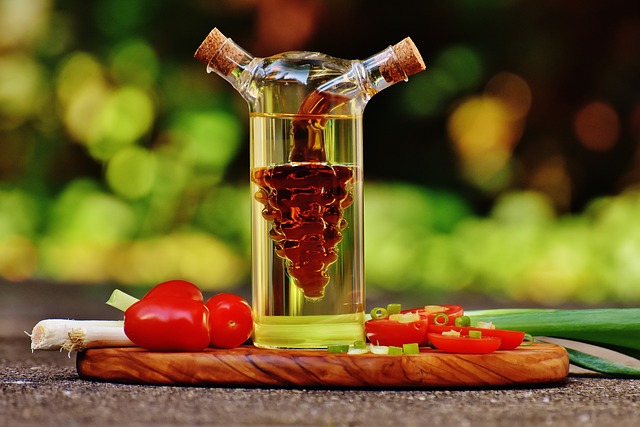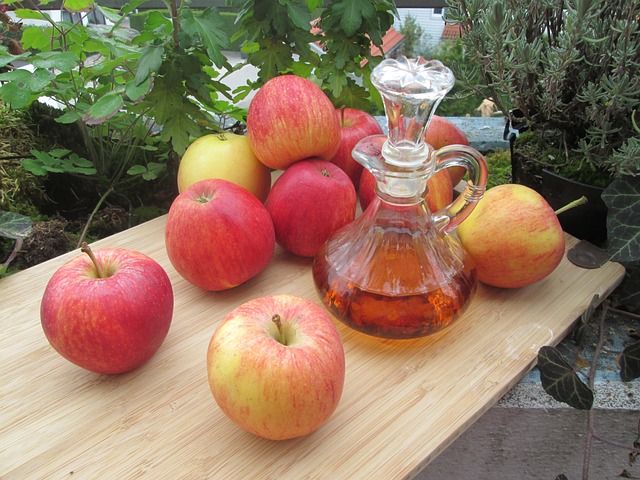Are you a foodie? Have you ever wondered what the difference is between white vinegar vs white wine vinegar? Many of us have an understanding of how to use them, but don’t understand the chemistry behind these two versatile ingredients. In this blog post, we will discuss why and when to use a specific type of Vinegar in your cooking. From exploring their origins to diving into the different applications for each one, we’ll make sure that by the end of it all, you are prepared next time you tackle a recipe!
Table of Contents
What Is White Vinegar?
White vinegar, also known as distilled vinegar, is a type of vinegar that is made from the fermentation of ethanol. It has a pale yellow to clear color, and is commonly used for cooking and cleaning. White vinegar can be used in many different recipes and applications, including baking, pickling, marinades, vinaigrettes, and sauces. It is also a popular household cleaner because it helps to dissolve mineral deposits and grease.
White vinegar has been around for centuries and is one of the oldest known organic acids. It derives its acidic properties from acetic acid which occurs naturally from acetic acid bacteria during the fermentation process. White vinegar typically has a 5% or 6% acetic acid concentration. This makes it less acidic than common vinegars such as cider or balsamic but still strong enough to be effective in cooking and cleaning.
When used in cooking, white vinegar adds a sharp acidic flavor that complements certain dishes such as fish tacos or salad dressings. Its sour taste can also help bring out other flavors in food like herbs or spices. White vinegar can also help tenderize meat when added to marinades due to its low pH level which breaks down proteins in the muscle tissue making them more tender when cooked.
White vinegar can be used for cleaning purposes due to its anti-bacterial properties. It’s perfect for removing soap scum on surfaces such as bathroom tubs and sinks because it not only kills bacteria but also helps break down minerals so they can be wiped away easily with water or a cloth rag. Additionally, white vinegar can remove odors from carpets by absorbing unpleasant smells without leaving behind any residue once dry.
With its wide range of uses from cooking to cleaning, white vinegar proves itself to be an invaluable ingredient both in the kitchen and around the house!
How Is White Vinegar Made?

White vinegar is a tart, sour liquid made from fermented grain alcohol, often distilled or white wine. It is commonly used for seasoning and cleaning in many kitchens around the world. The production process of white vinegar involves several steps that span multiple days.
The first step in making white vinegar is to create the base ingredient: an alcoholic solution. This can be done by fermenting fruits, grains, or vegetables such as apples, rice, and potatoes. The fermentation process converts the sugars present in these foods into ethyl alcohol molecules, which will later be converted into acetic acid. Once this alcoholic solution has been created, it must be poured into an open vessel and left to sit undisturbed for several days.
During this time, bacteria known as acetobacter feed on the ethanol molecules within the solution and produce acetic acid, which gives vinegar its distinct flavor and smell. As the concentration of acetic acid increases over time, so too does the overall acidity of the mixture; when it reaches 4-7% acetic acid content (depending on desired flavor), it can be considered finished white vinegar.
Once complete, some manufacturers may pasteurize their products to ensure longer shelf life and reduce impurities before packaging them for sale. In addition to being used for seasoning sauces and salads or cleaning surfaces around the house, white vinegar is also becoming increasingly popular among health-conscious individuals due to its many potential health benefits such as aiding digestion and reducing blood sugar levels.
What Is White Wine Vinegar?
White wine vinegar, also known as vinaigre de vin blanc in French, is a type of vinegar made from white wine. It usually has a light and slightly sweet flavor compared to other vinegars, making it an ideal ingredient for many types of salads, sauces, and marinades. White wine vinegar is typically made with white grapes or a combination of white grapes and other fruits like apples or pears. The fermentation process used to create the vinegar involves using bacteria to convert the sugars present in the fruit or grape juice into acetic acid, giving the vinegar its distinct sour flavor.
White wine vinegar can be found in most grocery stores and can be used in many different ways. It’s often combined with oil to make a classic vinaigrette dressing that can be used on salads or over vegetables. White wine vinegar is also great for marinating meats and fish before grilling. It helps tenderize the meat and gives it a nice acidic kick that balances out other flavors in the dish. Adding some minced garlic or herbs to white wine vinegar can give dishes an extra flavor boost too!
White wine vinegars can also be used for pickling vegetables like cucumbers or onions. The acetic acid content helps create a safe environment inside the jar for preserving foods while adding brightness to the final product too. Many people also use white wine vinegars for cleaning around their homes due to its disinfecting properties; it’s especially helpful for removing sticky residue from surfaces like countertops without leaving streaks behind.
No matter how you choose to use it, white wine vinegar is an essential pantry staple that will keep your cooking diverse and exciting!
How Is White Wine Vinegar Made?

White wine vinegar is made from fermented white wine and is a popular condiment that adds a tangy flavor to dishes. The process of making white wine vinegar begins with the production of white wine, using grapes or other fruits such as apples and pears. The fermentation process produces alcohol and converts it into acetic acid, which gives vinegar its distinctive sour taste.
Once the white wine has been fermented and aged, the next step in producing white wine vinegar involves cleaning and sterilizing the equipment used to make the vinegar. This helps ensure that any contaminants will not affect the quality of the final product. The fermentation process then continues in open air or enclosed tanks over a period of weeks or months at temperatures ranging from 55-85 degrees Fahrenheit (12 to 30 degrees Celsius). As temperatures rise, yeast cells convert ethanol into acetic acid. During this time, bacteria also break down sugars in the liquid mixture to produce lactic acid.
The last step in making white wine vinegar involves filtering and stabilizing it for long-term storage. This includes straining out particles such as grape skin, yeast cells, and other impurities from the liquid mixture before transferring it into containers for storage. Finally, an acidifier may be added to further lower its pH level and give it a sharper taste so that it can maintain its freshness longer when stored at room temperature.
White wine vinegars are widely recognized for their mild flavor profile compared to other types of vinegars such as balsamic or cider vinegar. They also have higher levels of tartaric acid compared with red wines, providing them with better flavor stability over time than some other varieties of vinegars do. White wines are also known for having fewer tannins than red wines, allowing them to be enjoyed without needing additional flavoring agents such as herbs or spices.
White Vinegar Vs White Wine Vinegar Comparison
When it comes to the debate of white vinegar vs. white wine vinegar, there are many distinctions between the two that should be noted. Both types of vinegar have their own distinct flavor profiles and uses in different recipes, but knowing which one is right for you largely depends on your individual preference.
White Vinegar is a clear liquid made from grains such as corn and wheat. It has a sharp, acidic taste and is often used as a cleaning agent due to its acidity level. White vinegar can also be used as a condiment in dressings and marinades, as well as certain dishes like pickles or chutneys. White vinegar also makes an excellent base for homemade cleaners and weed killers.
White Wine Vinegar, on the other hand, is made from fermented white wine that has been aged in oak barrels until it turns into a sour-tasting liquid. It has a more mellow flavor than white vinegar but still contains a noticeable tinge of acidity—perfect for giving dishes like salads or sauces an extra kick of flavor. White wine vinegar’s low acidity means that it won’t overpower foods like white vinegar could when used in recipes.
When comparing the two vinegars side by side, white wine vinegar holds up better against heat than its standard counterpart because it can tolerate high temperatures without losing its flavor or turning bitter. White wine vinegars usually contain fewer preservatives than normal white vinegars, making them healthier options for those looking for something with less additives added to the mix.
As far as cost goes, white wine vinegars tend to be slightly pricier than regular white vinegars due to the extra steps involved in creating them (namely aging them in oak barrels). However, this extra cost may be worth it depending on what type of dish you’re preparing — if you’re making something that requires both intense heat and subtle flavoring, then investing in higher quality ingredients such as white wine vinegar may help improve your dish’s overall taste profile significantly!
Ultimately, deciding between regular white vinegar versus white wine vinegar will depend on how much money you want to spend and what kind of flavors you prefer best when cooking or baking; however if you’re looking for something with more subtle flavor tones then opting for the latter may be the better choice over regular distilled white vinegars!
>>> Read more:
Best Air Fryer Consumer Reports
FAQs About White Vinegar Vs White Wine Vinegar

White vinegar and white wine vinegar are two vinegars that are commonly found in many kitchens. While the two are similar in color, there are some significant differences between them, which can make choosing one over the other a difficult decision. Here is a list of frequently asked questions about white vinegar vs white wine vinegar to help you better understand the differences:
What Is The Difference Between White Vinegar And White Wine Vinegar?
White vinegar is a type of distilled vinegar made from grain alcohol, while white wine vinegar is made from fermented grapes. Whitevinegar has almost no taste or odor, whereas white wine vinegar has a distinct sour taste and aroma. In terms of acidity, white vinegar typically has a higher acidic level (5-20%) than white wine vinegar (3-10%).
What Types Of Dishes Can I Use Each Type Of Vinegar For?
White vinegar is often used as an ingredient in salad dressings or marinades, as well as for pickling vegetables or fish. It’s also great for cleaning and removing stains on surfaces like countertops and floors. White wine vinegars have a more delicate flavor and can be used to add flavor to salads, sauces or vinaigrettes. They’re also popular in French cooking.
How Should I Store Each Type Of Vinegar?
To ensure that both types of vinegars last longer, it’s important to store them correctly. White Vinegar should be stored at room temperature away from direct sunlight; it does not need to be refrigerated unless opened for long periods of time. On the other hand, White Wine Vinegar should be stored in the refrigerator where it will last for up to one year after opening. Additionally, it’s always best to keep all types of vinegars away from heat sources such as stoves and ovens.
Are There Health Benefits Associated With Consuming Either Type of vinegar?
Consuming either type of vinegars may have potential health benefits since they contain acetic acid which helps reduce oxidant damage caused by free radicals in our bodies and may help control blood sugar levels when consumed with meals with carbohydrates. However, it’s best to always consult your doctor before adding any new foods into your diet plan – especially if you suffer from any dietary restrictions or medical conditions.
Can White Wine Vinegar Replace White Vinegar?
The simple answer to whether white wine vinegar can replace white vinegar is yes – although the flavor profiles of the two are slightly different. White wine vinegar is made from white wine, while white vinegar is usually made with grain-based alcohol. White wine vinegar has a milder, more complex flavor than white vinegar, with notes of sweetness and fruitiness. As such, it works better in certain types of dishes, such as salads and marinades for fish or chicken. It also pairs well with light cheese sauces and is often used to deglaze pans for making sauces.
White vinegar, on the other hand, has a sharper taste that can overpower some dishes. It holds its own in strong flavors like pickling or barbecue sauce but may be too sour for light dishes like salads or vinaigrettes. White grapevinegar offers a milder alternative when you don’t want to use regular white vinegar.
Is White Vinegar Or White Wine Vinegar Better For Cleaning?
Both white vinegar and white wine vinegar are excellent natural cleaning agents that can be used to tackle a myriad of household tasks.
White vinegar, also known as distilled vinegar, is made from grain-based ethanol that has been distilled to produce a colorless and odorless liquid. It is extremely acidic with a pH level of around 2-3, making it an effective sanitizing agent. It can kill most types of germs and bacteria, including E. coli and salmonella, which makes it perfect for cleaning food surfaces such as cutting boards and kitchen counters. White vinegar can also be used to clean windows, remove soap scum from tubs and showers, dissolve grease on pots and pans, unclog drains, polish metals such as brass or copper, and even eliminate odors in carpets or upholstery.

White wine vinegar is made from fermented white wine grapes. It contains some acetic acid like white vinegar but has a milder flavor due to other organic acids present in the grape juice such as tartaric and malic acid. Because it is less acidic than white vinegar with a pH level of around 3-4, it’s not as effective at killing germs but still works well enough for general cleaning applications such as removing dirt or hard water deposits from surfaces. It’s gentler on surfaces so it won’t damage delicate materials like wood furniture or marble countertops, which makes it ideal for more delicate tasks such as polishing silverware.
Overall both white vinegar and white wine vinegar are good for cleaning purposes but the slight difference in their acidity means they have different strengths when it comes to certain tasks. When choosing between them it’s important to consider what your particular needs are so you can select the best option for your specific application.
What Is The Best Use For White Wine Vinegar?
White Wine Vinegar is a versatile and flavorful condiment that can be used in a variety of recipes and dishes. It has a tart, acidic flavor that can be used to add an extra kick to many dishes, salads, and sauces. Here are some of the best uses for white wine vinegar:
– Salad Dressings – White wine vinegar is a perfect addition to any salad dressing and can be used as either the main ingredient or as an accent to other dressings such as balsamic or olive oil-based vinaigrettes. White wine vinegar will add a nice tangy flavor to your salad and help bring out the flavors of the other ingredients.
– Marinades – White wine vinegar has natural acidity which helps break down proteins, making it ideal for marinades. The sharp flavor will also give your food a unique twist. Use it in combination with other ingredients such as garlic, olive oil, herbs, spices, vegetables, red wines and more for tasty results every time!
– Sauces – The strong flavor of white wine vinegar pairs well with a range of sauces such as béarnaise sauce (a butter-based sauce), hollandaise sauce (an egg-based sauce) or even gravies and stews! You can also use white wine vinegar to deglaze pans after cooking meat or fish dishes – this will help bring out all the flavors from the pan while adding an extra zing of flavor!
– Pickling – White Wine Vinegar is perfect for pickling vegetables such as cucumbers or peppers due to its high acidity content and sharp taste which helps preserve vegetables while still maintaining their crunchiness. Plus you can make variations on pickled veggies by adding different spices or herbs like garlic or rosemary!
– Drinks – White Wine Vinegar makes a great addition to many drinks including sparkling water (for a refreshingly tart summer beverage!), teas (white tea with honey and white wine vinegar is amazing!) and smoothies (add white wine vinegar for an added boost!). It’s also excellent for creating shrubs which are sweet-tart syrup based drinks made with fruit juice, sugar, and acidity – often supplied by white wine vinegar!
>>> See more: Which White Wine Vinegar is the Best?
Conclusion
Though they may look similar, white vinegar vs white wine vinegar are two very different products with distinct uses. White vinegar is made from distilled grain alcohol that has been allowed to oxidize, while white wine vinegar is made by allowing fermented white wine to turn sour. Because of this key difference, the two vinegars can taste quite differently, with white vinegar being much more harsh. Additionally, white vinegar is typically cheaper than white wine vinegar. When cooking or cleaning, be sure to use the right type of vinegar for the job at hand – otherwise you may not achieve the desired results!
The Cafe Toscana Restaurant blog is all about great food and good times. From recipes to restaurant reviews, we’ve got you covered.

